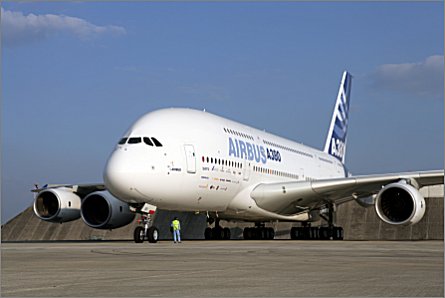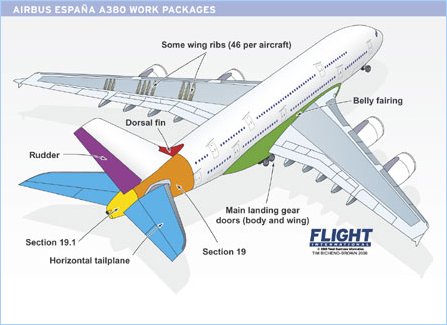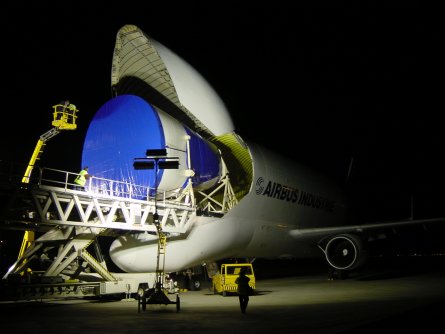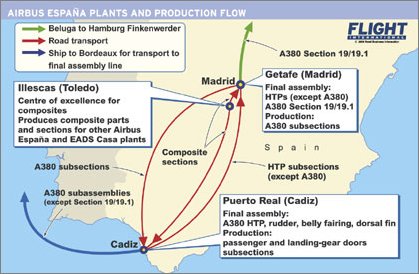In five years Airbus España has grown by half, become a centre of excellence for composites and won a 10% share on the A380, its biggest yet on any Airbus
The Airbus A380 has many striking attributes, such as its sheer size, double-deck cabin and giant wing. Less obvious, but arguably just as significant, are the huge composite structures produced in the manufacturer’s Spanish factories – the aft fuselage section and the huge horizontal stabiliser or, as Airbus calls it, the “HTP”.
|
| Spain is providing 10% of every Airbus A380 |
“It is curious that the Spanish joined the other two governments – France and Germany – and became a partner in Airbus before the British did,” says Airbus España general manager Manuel Hita.
|
The year 1969 was a significant one for the embryonic Airbus. In April that year the UK government decided that it did not wish its industry to be a formal shareholder in Airbus, and Hita recalls that about the same time Spain began to consider involvement. “In 1969 the Spanish government began to talk to the other two governments about the possibility to have a share for CASA,” he says.
From Airbus’s perspective, the more European partners on the programme, the greater the “home market” sales potential. And the Spanish airframer, which was producing military and small civil aircraft in its own right, already had established ties with French and German aerospace companies as a subcontractor, albeit on two fairly unsuccessful programmes – the HFB-320 Hansa-Jet and Dassault Mercure. In 1962 it had become a partner with Germany’s HFB on the Hansa-Jet business jet, building the rear fuselage and tail. However, production of the aircraft ceased in 1971 after just 50 aircraft had been built.
In 1969 CASA became a partner on the Mercure airliner programme, building the forward fuselage. Confidence was high in this 140-seat twinjet, and CASA’s tooling was capable of producing up to four aircraft a month.
Building bridges
But the programme ended in 1974 with after just 12 aircraft completed. As part of the Mercure contract, CASA produced a batch of outer wing assemblies for the Dassault Falcon 10 business jet, and also some sections of Mirage fighters.
Meanwhile Airbus had been founded in December 1970 as a 50/50 joint venture between the French and Germans, to build the world’s first widebody twinjet, the A300B. In November 1971, Spain officially came into the fold as a partner and the Airbus shareholdings were renegotiated to accommodate CASA, which was allocated a 4.2% stake – a figure based on the number of A300Bs likely to be acquired by Iberia. To keep its part of the bargain, the Spanish state-owned flag carrier undertook to order at least four A300Bs and take options on a minimum of eight. Iberia has gone on to buy 140 Airbus aircraft.
“The 4.2% participation allocated to the former CASA corresponded to the HTP work package for the original A300 programme,” says Hita, a structural engineer who joined CASA in 1969 and was involved with the Airbus workshare from the start. He became general manager of Airbus España in 2002. Hita adds that on later programmes the workshare has been adjusted case by case with other work packages to achieve the 4.2%, until the advent of the A380, when the Spanish share was increased to 10%.
“The main benefit to CASA being a partner in Airbus is that we have had the opportunity to design and engineer innovative new components for each consecutive Airbus model at a much higher rate than for our own products,” says Hita. “Each new HTP design since the original A300 has incorporated new innovation and technologies.”
Hita was directly involved in the transfer of the HTP work package from MBB in Germany to Spain when CASA joined Airbus. At the time it was being produced in metal, but the HTP was identified as an area where the then new carbonfibre technology could be deployed.
“The German and Spanish partners started simultaneously increasing the number of parts we were designing in composite – this was a decision that was very well received by the consortium as it gave the aircraft better performance due to lower weight,” says Hita.
At that time, Airbus was a consortium of independent companies and “we were working with little interchange of processes between the partners”, says Hita. “The composites processes we had differed in many respects to those used by the Germans – the temperature of the autoclave, the way in which we lay up, the tooling concept. There are advantages and disadvantages to each.”
However, this has completely changed now that Airbus is a single company, where “the transparency and the interchange of ideas and experience has been massive”, says Hita. “We work together to share the best practice for the whole process and we interchange our knowledge and experience across all four countries.”
New era for A350
An example of this is the design effort for the A350’s new composite wing, says Hita: “A team of German, French and Spanish engineers is co-located in the UK working jointly with the British engineers – the whole team is responsible for the design of the composite wing of the A350.”
The first significant use of carbonfibre in a primary structure was on the A310, which had a composite fin from 1985 and “we started to design some of the HTP components in carbonfibre”, says Hita.
|
| The Beluga is just capable of transporting the A380 rear fuselage section from Getafe to Hamburg |
The watershed for carbonfibre for CASA came with the A320 in 1987, which Hita says was the first Airbus aircraft to have “a massive use of composites” in the HTP, which was designed “completely in carbonfibre, except a few parts that were designed and made in titanium. It was the first primary structure built in Spain constructed of carbonfibre.”
The composites drive has continued with each new iteration of Airbus aircraft (see table). “The A330/A340’s HTP was designed with the central box in metal and the two lateral boxes and elevators in carbonfibre,” says Hita, adding that this was the last occasion metallic structures were used in the HTP, as stabilisers in the A340-500/600, A380 and A350 are all-composite.
Bigger bite
Improvements in the production process have arrived in parallel with the increased use of carbonfibre. “On the A320, we started with the traditional manual lay-up and curing process, utilising many tools to cure the parts. But we’ve now massively developed automatic processes,” says Hita.
This has seen three key carbonfibre production technologies refined – automatic tape lay-up (ATL), fibre placement and resin transfer moulding (RTM).
“With ATL we can make large parts that are flat, or have slight curvature, but once you start to design sections with large or double curvature like the A380’s rear fuselage, you can’t use the two-dimensional ATL method,” says Hita.
|
“For these sections, we developed a new process – fibre placement – which uses a small tape only a few millimetres wide and enables us to accommodate double-curvature shapes. We worked jointly with the manufacturers to develop machines in accordance with our requirements.”
The increase in Spain’s Airbus workshare, which saw it given responsibility for 10% of the A380, came in the wake of the government’s decision in 1998 to privatise CASA. In late 1999 CASA joined as a founder member of EADS, which was officially created in July 2000, by which time the Airbus partners had agreed that Spain’s share would be increased.
A year later, Airbus España was set up as a wholly owned division of Airbus (along with businesses in France, Germany and the UK) incorporating CASA’s Airbus factories at its plants in Getafe, Illescas and Puerto Real. Meanwhile, CASA’s non-Airbus components had been spun off into EADS Casa.
Hita says that the A380 workshare was not formally agreed until the programme launch in December 2000. To facilitate the increased Spanish workshare, the A380’s rear fuselage (two huge assemblies dubbed Section 19 and 19.1) was one of several additional work packages assigned to Spain (see box). “Until that point Section 19/19.1 was assigned to the German partner and designed as a metallic structure, but when design and construction was moved to Spain, straightaway we saw the possibility to move to carbonfibre,” says Hita. “In the late 1990s, we had been examining fibre placement technology to enable us to use carbonfibre for double-curvature parts in case we needed it for complicated fairings.”
In conjunction with Airbus’s technical and manufacturing staff, studies and trials were undertaken, and a demonstrator produced. “Finally at the end of 2001 we succeeded with all the tests and took the decision to design the rear section in composites for the first time – the Spanish team was the one that led this step forward in innovation,” says Hita.
The A380 Sections 19 and 19.1 together measure over 14m (46ft) in length, and over 6m in height. They are a mostly composite design, incorporating carbonfibre skin sections produced by the fibre-placement process, with some metallic frames and some carbonfibre frames produced using the RTM process. This marks the first use of composites in the fuselage of an aircraft larger than a 100-seater, and is also the first time that a carbonfibre structure has encased an engine – in this case the auxiliary power unit.
Further work
The switch from metal to composite typically nets a weight saving of 15-30%, depending on the design and the size of the structure, says Hita. Although he is guarded about the gain achieved in the A380’s rear fuselage, he says that “the weight saving with the cost increases incurred by moving to carbonfibre was enough to make the business case work”.
Having innovated on the A380, Airbus España is taking the process further on the A350, says Hita. “We are retaining Section 19/19.1 responsibility for the A350, and the major innovation we will introduce is to produce the skin with the stringers integrated in a single, 360˚ piece for the first time,” he says. “This is partly because of the maturity of the production process now, and partly because of the scale as the sections are smaller.”
The Spanish A350 workshare will be “a little bit less” than the 10% on the A380 because “we don’t have all the same work packages – for example the rudder is not our responsibility. Also the A350 is not totally brand new, so there are parts that will not be redesigned,” says Hita. Workshare arrangements should be finalised soon when the aircraft reaches the definition freeze milestone.
The use of composites for the rear fuselage gives Airbus the opportunity to refine the shape of the sections to a much greater degree than when using metal, says Hita. “With metal, the final design of a complicated aerodynamic shape such at the rear fuselage is a compromise between what the manufacturing people can do and what the aerodynamics want. The benefit of carbonfibre is that you can produce complicated double-curvature parts that cannot be produced in metal.”
With A350’s Section 19/19.1 being redesigned in carbonfibre, and the HTP already composite, “the optimised aerodynamic shape can be achieved,” says Hita. “This is under the responsibility of Airbus España.” ■
MAX KINGSLEY-JONES /GETAFE
Source: Flight International



























